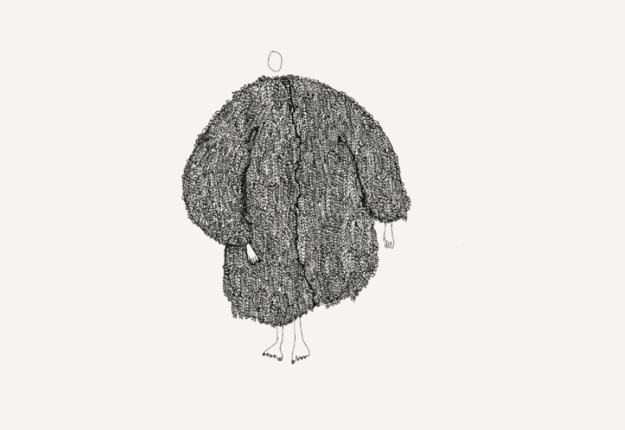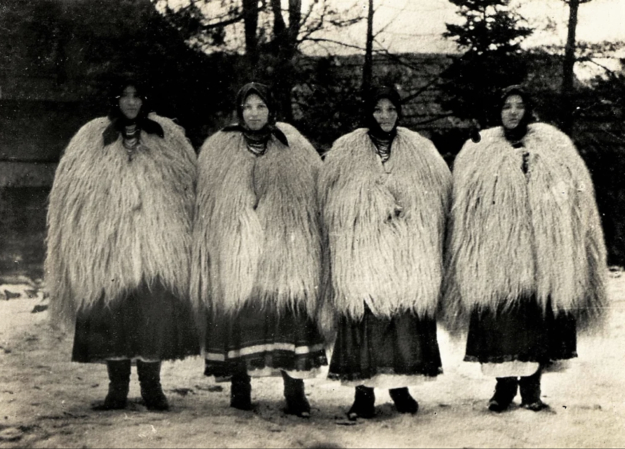What is a Gunya?
Gunya is a Ukrainian traditional wool coat, originally worn by Hutsul shepherds in the Carpathian mountains. Providing physical protection from severe weather and animals, throughout the years it has carried a deep symbolic meaning, serving as an amulet for its owners. Using the classic shepherd’s coat as a template, we tell stories of local materials, natural components and living organisms. The use of different cellulose and protein based materials in combination with natural dyeing techniques show the ample variety of outcomes and possibilities.
Origin of Project
The question of how to deal with wool waste is nowadays quite acute in the Netherlands. Dutch sheep ‘produce’ yearly approximately 2 million kilograms of wool. In the course of years, starting with the introduction of synthetic materials, the market for wool collapsed. Farmers had to pay to get rid of the wool and therefore didn’t care much about the quality anymore. With consistently declining demand for sheep wool, this by-product becomes a burden and the Dutch municipality has been forced to treat it as waste. Therefore, new ideas for using otherwise discarded sheep wool are urgently needed.
Last year, Dasha Tsapenko, received a Talent Development Grant from Stimuleringsfond to research possibilities of combining old textile craft techniques from her home country Ukraine with innovative processes of growing mycelium. Her goal was to incorporate mycelium in the process of weaving and use it as a binder and an additional aesthetic element proclaiming the joint character of old and new in contemporary design. She wanted to create a new bio-based material that would combine both Ukrainian old-time traditional craftsmanship and Dutch Innovation in material development. To achieve the traditional craft part, she asked to collaborate with a Ukrainian weaver Ruslana Goncharuk, who inherited from her grandmother and then mother a specific technique of weaving garments – gunyas. In former times gunyas were worn by shepherds, due to the warmth and water-resistant properties of these garments.
To make a Gunya, the wool is evaporated in hot water for 5 hours, then washed in cold river water. Dried wool is plucked and combed with iron brushes. As a result, two types of wool are obtained: a better one and a worse one. From the best wool thin threads are made, which are twisted in half and cut into pieces of 30-35 cm, which are stretched through a special hand machine by a shuttle through three threads in a way, that the right side of the piece becomes shaggy and fluffy and the left side - smooth.
The Gunyas
The different Gunyas form groups and comment on each other. There are models from mycelium, hemp and different types of wool. Some are soft, others imposing, some are statements, while others are carriers. All models are the same size and are sewn together in the same way, by hand. They are meant to trigger senses inviting to be touched.
Mycelium
The mycelium Gunyas are made by Dasha Tsapenko. She uses the technique developed together with Prof. Dr. Han Wösten. Industrial hemp serves as food for various fungal species. Mycelium serves as a binding agent for short hemp fibers left from hemp processing. Upcycling leftover hemp and teaming it with mycelium creates an aesthetic and natural material with a variety of applications. The living material invites to be explored with all senses, not only by vision, but also by scent and touch. Due to unpredictable behavior of living fungal species involved, each grown piece is unique. The Gunyas on show are grown from various polypore fungi strains, native to the Netherlands.
Weaving techniques
The woven gunyas are made on a two-stage loom using an ancient technique that for centuries has been handed down from generation to generation. All woven models are made by Ruslana Goncharuk, who came to the Netherlands from the city of Yavoriv the Carpathian Mountains, where she lives and has her practice. In Eindhoven, together with Dasha Tsapenko and Marjo van Schaik, she weaved a traditional Gunya on a local loom, using local components for dying the Ukrainian yarn.
Wool
There are models made of felted wool, where the wool comes from Dutch farmers. This wool is considered waste in the Netherlands, for which the farmer has to pay for disposal. The wet felting of raw sheep wool results in a nice, warm and sturdy coat. As an illustration of our current views on ‘waste’, two Gunyas felted in exactly the same way are put together: one made of high quality wool from long-haired hobby sheep and another one from the wool, considered as waste. Also Marjo van Schaik designed a model, which besides being a shelter for humans, provides shelter for seeds – as a painful reminder of the destroyed seed bank in Kharkiv, Ukraine
Cooking & Dying
Colour is a powerful tool in traditional Ukrainian weaving. Despite having a rich history in natural dyeing, the contemporary dye used in Ukraine is often chemical. Here, the yarns for traditional woolen and hemp gunyas are dyed with leftover ingredients used for cooking Borsch – a Ukrainian traditional soup. The natural dyes retrieved from edible crops act differently on wool and hemp and it will be a question to what extent the beetroot colour remains visible during the exhibition. Beetroot is the main ingredient of this Ukrainian meal soup. However, this is normally not used as dye as it is not colourfast. The dyeing experiments were carried out by Marjo van Schaik and Dasha Tsapenko.
Fungal dye
One of the biggest problems in the fashion industry is water pollution from harmful textile dyes. Ilse Kremer found several fungal species that produce pigments that can be used for dyeing. Fungal dyes have many advantages over synthetic textile dyes and other dyes. Ilse Kremer dyed a wool Gunya with her uniquely developed fungal dye.





